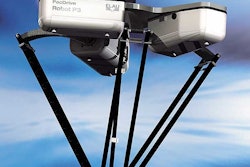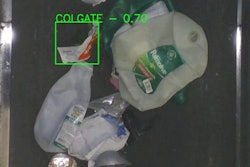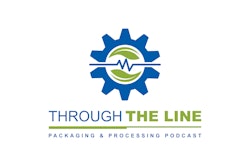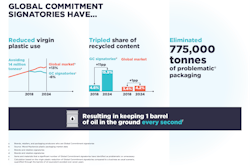In this video clip Pester Pac has integrated a 2-axis Delta robot for collating and indexing product entering its compact shrink wrap machine.
Handling and packaging strategies fulfilled by robotics include adapting to different batches on the fly, varying the grouping patterns of products, and handling vastly different products on the same line by exchanging grippers.
Robots are ideal for processing irregularly shaped objects. For example, a vision equipped robot is used for applying seasoning to steaks.
This adaptability means reusability. Robots save engineering costs and time because they are reusable or reprogrammable modules. This applies to the software as well as the mechanics. Robots are also scaleable, meaning throughputs can be increased by adding robot modules (see Adabot and Nuspark stories).
What are the considerations for developing the freedom of movement required for efficient robotic packing? First is to select the right arm for the job. (Note that 2- and 3-axis deltas refer to their fundamental arm configurations, additional servo axes are often applied).
• 3-axis delta for high speeds and light loads, a category we’ll see more of in the coming months as the concept entered the public domain in Europe a year ago and the U.S. in late 2007
• 2-axis delta for heavier payloads, deeper reach into cases, and collating – a very popular arm to fulfill the current trend toward robotics in secondary packaging
• Articulated, traditionally used for case packing and palletizing, but in smaller sizes useful for carton erecting, filling and sealing (see Cavanna sidebar story)
• Gantry and portal, typically used for traditional palletizing and for handling heavy payloads and lower speeds
Motion control considerations
Advanced mathematical algorithms are the key to smoothly coordinate the robot arm’s multiple joints, wrist actions and linear travel. While some simple gantries uses point-to-point positioning, the real efficiencies come when motions are fluid, fast and focused on the tool center point.
Different degrees of freedom are possible, depending on the control software and the manipulator, with a given envelope or workspace. Cartesian movements are inherent to the control system. Both the motion and mechanics are very flexible.
Tool Center Point (TCP) represents a fundamental distinction between machine and robotic motion design. In mechatronic packaging machines, motions are defined as a set of trajectories for each servo axis. These trajectories are individually calculated and are synchronized by a virtual camshaft. The various mechanical components operate in unison and can be adjusted dynamically. Compared to robots, only simple kinematics are available.
In robots, motions are related to the TCP and not to individual axes. Motions are defined by the target position and type of movement of the robot arm. The required trajectories for each motor are calculated by the controller at runtime. Therefore, the path can easily be changed at runtime.
Commercially available development tools
To overcome the need for the specialized kinematic skills noted in a definitive ARC report on robots in packaging, motion control toolkits have been introduced in the past three years that offer robotics libraries. It is possible for the engineer to program cartesian motion just as he or she would for a conventional machine, into an IEC 61131-3 Function Block from this library, then apply a transformation Function Block that performs all the necessary kinematics.
This is the software breakthrough that has permitted so many packaging systems designers to implement robotics, allowing them to focus on their core mechanical engineering competencies, to optimize arm designs and materials, and to apply their expertise to the packing function and package characteristics.
When all the machine functions are embedded in Function Blocks, it is possible for programs to be developed in a modular structure, which improves diagnostics, reusability and response to inputs.
Robotic systems can then be designed as modules linking together concatenable Function Blocks to perform the transformation (a.k.a. trafo) necessary, for example, for a familiar 6-axis articulated robot, plus a trafo for the wrist movement and a trafo for the end-of-arm tool actuation.
As the ARC report states, “Machine modularity is allowing machine builders to configure a packaging machine based on functional subsystems such as bottle carousels, labelers and wrappers. Integration of a robotic manipulator further leverages the concept of modularity…”
What to look for in development kits
Robots are capable of developing some G forces, and too much can overcome the gripper’s holding force on the product. Therefore, intelligent acceleration monitoring is a desirable feature of the development environment, to limit accelerations and velocities and contain the resulting centrifugal forces.
The motion commands should include point-to-point, linear or circular interpolation, and splines. Spline curve algorithms map a continuous path between start and target points. Look for a geometrical blending capability to reduce cycle times by ‘blending’ the path to optimize speed and distance traveled to reach the target point. You should be allowed to define your criteria for target point, velocity, acceleration and jerk.
The program should be able to keep both forward and backward movements on the same path – and this is harder than it might first appear, like backing up in your car at 60 mph. Likewise, it should stay on path during an e-stop.
The program should be able to precisely trigger peripheral motions, such as indexers, wrappers and sealing mechanisms.
Other considerations
It is simpler and the response time faster to integrate robotics with packaging machine operations when control is centralized in a single controller. However, the controller must then be powerful enough to manage one or more robot arms plus all related functions, such as belt tracking and vision systems.
Many controls vendors today claim robotic control among their bag of tricks. But ease of development, ease of operation, integration with the rest of the packaging machine, response time to adjust an ongoing motion, such as changing belt velocity and just plain speed can vary greatly. Be sure to put each supplier through the paces, especially when it comes to checking out the performance of robotic packaging machines that have been developed using their technology.
About ELAU
ELAU, Schneider Electric’s packaging specialist, is the only company worldwide exclusively focused on the automation of packaging machinery. ELAU’s PacDrive™ automation system offers the only automation platform purpose-built for the packaging industry.
ELAU equips over $1 billion worth of the world’s best machines annually, with over 35,000 PacDrive systems already deployed in packaging machinery worldwide.
The market demands packaging operations that are more flexible and efficient to fulfill marketing, supply chain and global business strategies. ELAU innovations have enabled a revolution in mechanical, software and hardware modularity to deliver these agile packaging systems.
Now ELAU invites the worldwide packaging community to take modularity to the next level with our new PacDrive™ Intelligent Servo Modules.
Far more than just distributing the servo drive out onto the motor, servo modules enable plug-and-play modularity, literally plugging machine modules into or out of the packaging system to change functionalities, formats and capacities.
By vastly streamlining the networks, cabling, interconnects and electrical hardware, Intelligent Servo Modules smaller, simpler, more maintainable and reconfigurable.
For more information, visit www.elau.com or email [email protected].


























